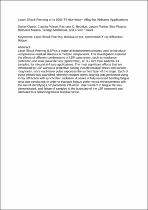JavaScript is disabled for your browser. Some features of this site may not work without it.
- ResearchSpace
- →
- Research Publications/Outputs
- →
- Conference Publications
- →
- View Item
| dc.contributor.author |
Glaser, D

|
|
| dc.contributor.author |
Polese, C

|
|
| dc.contributor.author |
Bedekar, RD

|
|
| dc.contributor.author |
Plaisier, J

|
|
| dc.contributor.author |
Pityana, Sisa L

|
|
| dc.contributor.author |
Masina, Bathusile N

|
|
| dc.contributor.author |
Mathebula, T

|
|
| dc.contributor.author |
Troiani, E

|
|
| dc.date.accessioned | 2016-07-22T07:43:19Z | |
| dc.date.available | 2016-07-22T07:43:19Z | |
| dc.date.issued | 2014-03 | |
| dc.identifier.citation | Glaser, D, Polese, C, Bedekar, RD, Plaisier, J, Pityana, S, Masina, B, Mathebula, T and Troiani, E. 2014. Laser shock peening on a 6056-T4 aluminium alloy for airframe applications. In: 11th International Fatigue Congress, Fatigue 2014, 2-7 March 2014, Melbourne, pp 974-979 | en_US |
| dc.identifier.uri | http://www.scientific.net/AMR.891-892.974 | |
| dc.identifier.uri | http://hdl.handle.net/10204/8680 | |
| dc.description | 11th International Fatigue Congress, Fatigue 2014, 2-7 March 2014, Melbourne, Australia. Due to copyright restrictions, the attached PDF file only contains the abstract of the full text item. For access to the full text item, please consult the publisher's website | en_US |
| dc.description.abstract | Laser Shock Peening (LSP) is a material enhancement process used to introduce compressive residual stresses in metallic components. This investigation explored the effects of different combinations of LSP parameters, such as irradiance (GW/cm(sup2)) and laser pulse density (spots/mm(sup2)), on 3.2 mm thick AA6056-T4 samples, for integral airframe applications. The most significant effects that are introduced by LSP without a protective coating include residual stress and surface roughness, since each laser pulse vaporizes the surface layer of the target. Each of these effects was quantified, whereby residual stress analysis was performed using X-ray diffraction with synchrotron radiation. A series of fully reversed bending fatigue tests was conducted, in order to evaluate fatigue performance enhancements with the aim of identifying LSP parameter influence. Improvement in fatigue life was demonstrated, and failure of samples at the boundary of the LSP treatment was attributed to a balancing tensile residual stress | en_US |
| dc.language.iso | en | en_US |
| dc.relation.ispartofseries | Worklist;14326/12636 | |
| dc.subject | Laser Shock Peening | en_US |
| dc.subject | LSP | en_US |
| dc.subject | Materials research | en_US |
| dc.subject | Aluminium alloys | en_US |
| dc.subject | Airframe materials | en_US |
| dc.subject | Residual stress | en_US |
| dc.subject | Synchrotron X-ray diffraction | en_US |
| dc.subject | Fatigue | en_US |
| dc.title | Laser shock peening on a 6056-T4 aluminium alloy for airframe applications | en_US |
| dc.type | Conference Presentation | en_US |
| dc.identifier.apacitation | Glaser, D., Polese, C., Bedekar, R., Plaisier, J., Pityana, S. L., Masina, B. N., ... Troiani, E. (2014). Laser shock peening on a 6056-T4 aluminium alloy for airframe applications. http://hdl.handle.net/10204/8680 | en_ZA |
| dc.identifier.chicagocitation | Glaser, D, C Polese, RD Bedekar, J Plaisier, Sisa L Pityana, Bathusile N Masina, T Mathebula, and E Troiani. "Laser shock peening on a 6056-T4 aluminium alloy for airframe applications." (2014): http://hdl.handle.net/10204/8680 | en_ZA |
| dc.identifier.vancouvercitation | Glaser D, Polese C, Bedekar R, Plaisier J, Pityana SL, Masina BN, et al, Laser shock peening on a 6056-T4 aluminium alloy for airframe applications; 2014. http://hdl.handle.net/10204/8680 . | en_ZA |
| dc.identifier.ris | TY - Conference Presentation AU - Glaser, D AU - Polese, C AU - Bedekar, RD AU - Plaisier, J AU - Pityana, Sisa L AU - Masina, Bathusile N AU - Mathebula, T AU - Troiani, E AB - Laser Shock Peening (LSP) is a material enhancement process used to introduce compressive residual stresses in metallic components. This investigation explored the effects of different combinations of LSP parameters, such as irradiance (GW/cm(sup2)) and laser pulse density (spots/mm(sup2)), on 3.2 mm thick AA6056-T4 samples, for integral airframe applications. The most significant effects that are introduced by LSP without a protective coating include residual stress and surface roughness, since each laser pulse vaporizes the surface layer of the target. Each of these effects was quantified, whereby residual stress analysis was performed using X-ray diffraction with synchrotron radiation. A series of fully reversed bending fatigue tests was conducted, in order to evaluate fatigue performance enhancements with the aim of identifying LSP parameter influence. Improvement in fatigue life was demonstrated, and failure of samples at the boundary of the LSP treatment was attributed to a balancing tensile residual stress DA - 2014-03 DB - ResearchSpace DP - CSIR KW - Laser Shock Peening KW - LSP KW - Materials research KW - Aluminium alloys KW - Airframe materials KW - Residual stress KW - Synchrotron X-ray diffraction KW - Fatigue LK - https://researchspace.csir.co.za PY - 2014 T1 - Laser shock peening on a 6056-T4 aluminium alloy for airframe applications TI - Laser shock peening on a 6056-T4 aluminium alloy for airframe applications UR - http://hdl.handle.net/10204/8680 ER - | en_ZA |






